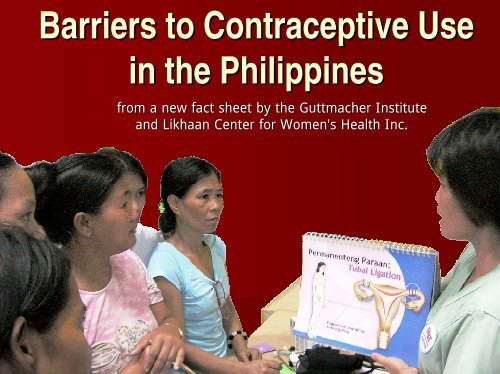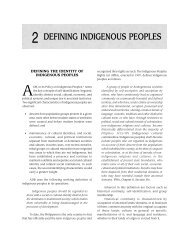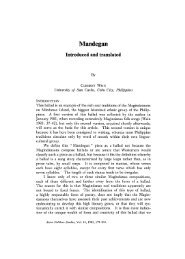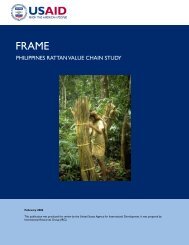Barriers to Contraceptive Use in the Philippines - Philippine Culture
Barriers to Contraceptive Use in the Philippines - Philippine Culture
Barriers to Contraceptive Use in the Philippines - Philippine Culture
You also want an ePaper? Increase the reach of your titles
YUMPU automatically turns print PDFs into web optimized ePapers that Google loves.
<strong>Barriers</strong> <strong>to</strong> <strong>Contraceptive</strong> <strong>Use</strong><strong>in</strong> <strong>the</strong> Philipp<strong>in</strong>esfrom a new fact sheet by <strong>the</strong> Guttmacher Instituteand Likhaan Center for Women's Health Inc.
<strong>Contraceptive</strong>s & <strong>the</strong> MDGsGoal 5. Improvematernal healthTarget 5.A:Reduce by 3/4, between1990 & 2015, <strong>the</strong>maternal mortality ratioTarget 5.B:Achieve, by 2015,universal access <strong>to</strong>reproductive healthIndica<strong>to</strong>rs:• MMR• births attended by skilledhealth personnel• <strong>Contraceptive</strong> prevalence• Adolescent birth rate• Antenatal care• Unmet need for FP
Sources of un<strong>in</strong>tendedpregnancy risksBIGGEST RISKScan getpregnant,want <strong>to</strong>space orlimitchildren,but…not us<strong>in</strong>g anymethod -"unmet need"us<strong>in</strong>gtraditionalmethodsun<strong>in</strong>tendedpregnanciesmaternalcomplications& deaths,abortion,unplannedbirths, o<strong>the</strong>rconsequencesmodernmethod failure& o<strong>the</strong>r risks
Rich & poor face highun<strong>in</strong>tended pregnancyrisks…15…but poorwomen'sunmetneed gives<strong>the</strong>m <strong>the</strong>highestriskTrad. Method<strong>Use</strong>rs17171717Unmet Need21 20 21 2328% of married women of reproductive age, NDHS 2008Richest Richer Middle Poorer Poorest
%, most recent source of supply, NDHSFailure <strong>to</strong> replace USAID supplies100Govt (nat'l & local) as most recent source, %75pillsall modern methodscontraceptivephase-out50condoms2006 poverty l<strong>in</strong>e (33%)462501993 1998 2003 2008227eventuallyhitt<strong>in</strong>g <strong>the</strong>poor
Discrim<strong>in</strong>a<strong>to</strong>ry policyDOH buys vacc<strong>in</strong>es & anti-TB drugs forlocalities, while spend<strong>in</strong>g zero oncontraceptives despite budget availability2010 DOH MOOE Budget for AmountTB ControlVacc<strong>in</strong>e-Preventable Disease ControlFamily Health <strong>in</strong>clud<strong>in</strong>g Family Plann<strong>in</strong>g1.11 B1.02 B0.93 B
LGU contraceptive banNGO FP outreach us<strong>in</strong>g makeshift cl<strong>in</strong>ic, MANILA 2009
Manila community hit bycontraceptive ban
Reasons for non-use by women withunmet needHealthconcernssameUnlikely <strong>to</strong> bepregnant<strong>in</strong>crease20032008Cost<strong>in</strong>creasePersonal orreligiousoppositiondecrease0 10 20 30 40 50% of women with unmet need, NDHS 2003 & 2008
ConsequencesPreventable if all women whowanted <strong>to</strong> avoid a pregnancyused modern methods:• 800,000 un<strong>in</strong>tended births• 500,000 abortions• 200,000 miscarriages• 2,100 maternal deaths• o<strong>the</strong>r health, economicand social costs
Stagnation <strong>in</strong> maternal death reduction500400▬ NSO surveys, direct sisterhood ........... slight decl<strong>in</strong>e▬ NSO vital registration data ................. no decl<strong>in</strong>e• WHO, adjusted sisterhood data ........... almost same as NSO• Hogan et al estimates (Lancet 2010) ... rapid decl<strong>in</strong>e (be<strong>in</strong>g questioned)300200213209200172 162100Target 5201980 1985 1990 1995 2000 2005 2010 2015
Poor women & families suffer mostUn<strong>in</strong>tended birthsper woman among richest: 0.3among poorest: 2
New path for <strong>the</strong> new adm<strong>in</strong>istrationFive Immediate Doables1. Res<strong>to</strong>re "cafeteria policy"• support for <strong>the</strong> widest rangeof FP choices2. Buy contraceptives• use DOH 2010 FP budget3. Reverse LGU bans• use standard-sett<strong>in</strong>g sett<strong>in</strong>g ®ula<strong>to</strong>ry authority
New path for <strong>the</strong> new adm<strong>in</strong>istrationFive Immediate Doables4. More PhilHealth fund<strong>in</strong>g• e.g., 3-year 3birth spac<strong>in</strong>g FPsupplies <strong>in</strong> maternity carepackage5. Focus on quality of carestandards and tra<strong>in</strong><strong>in</strong>g
New path for <strong>the</strong> new adm<strong>in</strong>istrationMore Doables• Pass <strong>the</strong> RH bill• Promote FP as one of <strong>the</strong>key pillars of reduc<strong>in</strong>gmaternal mortality• S<strong>to</strong>p us<strong>in</strong>g health forpolitical-religiouspatronage
In sum• <strong>Contraceptive</strong>s and reproductive healthare part of <strong>the</strong> MDG• Hardly any progress <strong>in</strong> contraception <strong>in</strong><strong>the</strong> past decade• Government failures & quality of careproblems are <strong>the</strong> key barriers• Lives and health, especially of <strong>the</strong> poor,are threatened• The new adm<strong>in</strong>istration can still changecourse <strong>to</strong> achieve <strong>the</strong> MDG

















